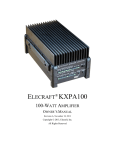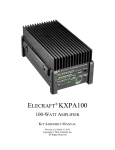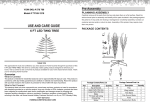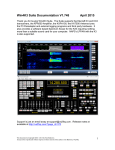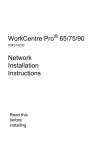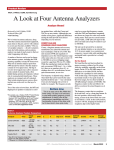Download ELECRAFT KXPA100 Instruction manual
Transcript
The Elecraft KXPA100 100 watt Amplifier and KXAT100 Autotuner Phil Salas – AD5X Introduction Besides my main station Elecraft K-Line (K3/KPA500/KAT500), I also own a KX3 transceiver that I primarily use for portable operation. Therefore I was extremely interested when the ARRL asked me to review the new 100-watt KXPA100 160-6 meter linear amplifier. The KXPA100 is clearly designed to seamlessly interface with the KX3 transceiver, however is also designed to work with any QRP rig. And an optional internal wide-range automatic antenna tuner provides antenna system flexibility when necessary. The KXPA100 is available factory built and tested, or as a no-solder kit. The unit reviewed here is the KXPA100/KXAT100 no-solder kit. Figure 1: Elecraft KXPA100/KXAT100 Front and Rear views First – the build! The KXPA100/KXAT100 arrived in a small 7.5” x 11.5” x 13” box. Inside were two boxes containing the fully assembled and tested main RF assembly and the KXAT100 tuner assembly, and a box containing the cabinet and associated hardware. See Figures 2 and 3. Figure 2: KXPA100 arrives! Figure 3: Kit sub-assemblies Figure 4 shows the completed amplifier just before attaching the cover. The bottom two pc board assemblies (amplifier and filter) come pre-mounted to the heatsink. Assembly consists of mounting the UHF connectors and serial port jack to the back panel, and then installing the front panel and full cover. If you have the KXAT100 autotuner (the top pc board assembly), you simply remove four mounting screws on the amplifier, install four standoffs, plug in the KXAT100, and re-install the four mounting screws on the tuner assembly. Assembly requires only basic mechanical skills. Just follow the excellent instruction manual (which is also available on the Elecraft web site), check off each step as you complete it, and before you know it you’ll be finished! In my case, this was about 1.5 hours from the time I opened the main box until I was ready to apply power. Figure 4: Ready for the cover KXPA100 Amplifier Technical Details The KXPA100 is powered directly from a standard +13.8VDC power supply capable of at least 20-amps continuous current (24 amps peak). There is no fan – i.e. a large heatsink provides the necessary thermal protection. A handle on the left side provides ease of transport. And special rubber feet permit the amplifier to be mounted vertically (front panel down) or in its normal horizontal upright position. The amplifier outputs 100 watts from 160-6 meters with typically 5 watts of drive. PINdiode T/R switching provides silent QSK operation. And the T/R switch is specifically designed to handle switching even with RF applied should a fault cause the amplifier to be bypassed. There is no amplifier bypass switch. However a relay bypasses the KXPA100 when it is powered off, when the relay is commanded off by the KXPA Utility program, or when a KX3 interfaced with a KXPACBL cable is set to 10W or less (or has its PA MODE menu setting OFF). This eliminates PIN-diode switch loss (less than 1dB) when operating QRP “barefoot”. However, with non-KX3 QRP radios the amplifier should be turned off when QRP operation is desired. If a non-KX3 radio transmits when the KXPA100 is on but not keyed, transmit RF passes through the receive path. While there will be no receive path damage with transmit power up to 15 watts, the PIN-diode receive biasing is such that significant out-of-spec harmonics will be generated. This was not clear in the Revision A KXPA100 User Manual, and so we thought there was a problem with the amplifier. Our KXPA100 was returned to Elecraft for analysis, which resulted in a manual revision for clarification. Our returned KXPA100 did benefit from two Elecraft hardware updates. The first was a digital noise reduction improvement, and the second was the addition of diode isolation of the T/R control line to prevent an external amplifier control line from back-feeding into the KXPA100 internal switching. Any KXPA100 returned for any reason will receive these updates at no charge. The KXPA100 includes always-active frequency-sensed auto band-switching making auto band-switching compatible with all transceivers. When a band change occurs amplification is disabled, the correct low-pass-filter and input network is selected, time is given for the relays to settle, and amplification is re-enabled. KX3 users can also take advantage of auto band-switching without transmitting via the optional KXPACBL cable, though frequency sensing always takes precedence. The KXPA100 Display and Fault System There is significant control, monitoring and display information available on the KXPA100’s front panel. The bottom row of controls and indicators for SWR, mode, antenna selection and ATU functions are present only if the optional KXAT100 antenna tuning unit is installed. DC power to the KXPA100/KXAT100 is controlled by the OFF/ON switch on the amplifier, or by a KX3 if connected with the KXPACBL. LED Amplifier Status Indicators show output power in watts, whether the rear panel input attenuator is switched in or not, and if the amplifier is being keyed. Faults are displayed on the amplifier LEDs, and on a KXPACBL-connected KX3 display. Faults include high SWR, excessive drive, excessive output power, high current, and a system fault which requires a KX3 or the KXPA Utility for more details. A fault condition suspends normal operation, normally by bypassing the amplifier. The exception occurs when drive over 8-watts causes the 3dB input attenuator to switch in. Faults clear automatically after a delay of about 8 seconds when the condition causing it is corrected. After clearing, the fault message remains on the KX3 display until any key is pressed. Setting Up the Amplifier Begin by installing 25-amp fuses in the supplied DC cable fuse holders if they are not pre-installed. Then connect +13.8VDC and turn on the amplifier. Connect a PC via the USB or RS232 interface and download and install the KXPA Utility. Update the firmware to the latest version if necessary. Connect a ground wire, RF IN/OUT and PA KEY cables to your transceiver. The PA KEY interface is compatible with all transceivers. The optional KXPACBL cable package provides the KX3 data interface and amp-keying connections. Performance Measurements Table 1 summarizes the measured amplifier performance. Table 1: Elecraft KXPA100, serial number 0555 Manufacturer's Specifications Measured in ARRL Lab Frequency Range: All amateur frequencies in 160, 80, 40, 30, 20, 17, 15, 12, 10, 6 meters. the range of 1.8 to 29.7 and 50-54 MHz. Power supply and current: 12-15 V dc (13.8 V dc 19 A maximum, 17 A typical (HF). 11 A (50 MHz) nominal), at 24 A peak capacity. at 13.8 V dc. Power output: 100 Watts, continuous HF, 80W As specified; 88 W (HF), 65 W (50 MHz) at minimum at 50 MHz. specified operating voltage. Driving power required: 5-7 Watts. 4-6 Watts (typical). See Table 2. Input VSWR 1.5:1 or less See Table 2. Spurious and harmonic suppression: not specified. Typically 52 to 64 dB, except 44 dB at 1.8 MHz¹. Meets FCC requirements. Third order intermodulation distortion (IMD): 14 MHz, 3rd/5th/7th/9th: –32/–34/–42/–52 dB 36 dB below full power output. below PEP (14 MHz); –31/–35/–40/–51 dB below PEP (50 MHz). Key In: Receive +5 Vdc open circuit, As specified. ground to transmit (1 mA maximum). TR switching time: not specified. Amplifier key to RF output: 3 ms; Amplifier un-key to RF power off: 8 ms. Size (HWD): 4.6 x 5.3 x 9.8 inches (including protrusions) Weight, 5.3 lbs. (including ATU) ¹Second Harmonic. Harmonic is reduced as frequency increases on the 160 meter Amateur Band. Other Specifications: Duty Cycle at 100 W Output RTTY/Digital/FM, 60 seconds continuous carrier. 100 watts continuous transmission on CW/SSB with a 50% duty cycle keying/modulation waveform. Thermally protected. Efficiency ~50% at 100 watts output. We did have a problem running our normal 2-tone tests in that the IMD performance was poor. This did not occur when the driving transceiver was a KX3 with its amplifier interface cables. Elecraft investigated this and determined that the wrong band was sometimes being selected at low 2-tone power levels. The KXPA100 defaults to 6 meters on power-up unless it is tracking an attached KX3. It then uses frequency sensing to select the correct band for a non-KX3 driving transceiver. However, below about 0.5 watts the KXPA100 frequency counter becomes unreliable. So when a low-level 2-tone signal is input the counter was getting confused, resulting in either no band change or a change to the wrong band. In normal operation, even with SSB, low-level counter operation was reliable. However, because of this particular issue Elecraft changed the firmware to more reliably select the correct low-pass filter at very low power levels. The new firmware should be production released by the time this review is published. Table 2 details the measured amplifier input SWR and required drive for 100 watts output (typically 4-6 watts of drive is required for full output). The KXPA100 bargraph display and Utility power readings are pre-calibrated at the factory. The bargraph readings are fairly coarse as power is indicated in 10-watt increments. I did find some discrepancies – particularly on the higher bands - between the bargraph display and Utility readings when compared to my NIST-traceable Minicircuits PWR-6GHS+ sensor and calibrated attenuators. TABLE 2: Serial Number 555 Amplifier Measurements: +13.9VDC Key-Down voltage, Unkey 0.28amps, key down no drive 1.15 amps Band Drive Input SWR Pactual Pbargraph Putility DC Current 160M 4.50W 1.52:1 100W 100W 99W 17.1A 80M 4.90W 1.49:1 100W 100W 98W 17.8A 40M 4.90W 1.44:1 100W 100W 97W 15.4A 30M 5.20W 1.33:1 100W 100W 97W 13.6A 20M 3.30W 1.56:1 100W 100W 96W 13.1A 17M 4.00W 1.53:1 100W 90W 95W 17.4A 15M 4.60W 1.35:1 100W 90W 94W 17.2A 12M 3.60W 1.29:1 100W 90W 92W 13.2A 10M 4.40W 1.40:1 100W 90W 92W 17.2A *6M 3.20W 1.27:1 80W 70W 70W 12.5A *The 6-meter output power specification is 80 watts. While this unit easily achieved 100watts on 6-meters (6.2 watts drive was required), power should be limited to 80 watts for best IMD performance when using linear modes. The Elecraft KXAT100 Automatic Antenna Tuner Unless you have an almost perfect antenna system the optional internal KXAT100 antenna tuner is worth considering. Table 3 lists the KXAT100 specifications. Table 3: KXAT00 Antenna Tuning Unit (ATU) Frequency Range: 1.8 to 54 MHz, continuous. Autotune Power: 3-watts minimum, 5-watts typical. Tuner configuration: Series-L/Shunt-C, reversible-L matching network. L/C Tuning Ranges: 8-capacitors (2624pf max) and 8-inductors (17370nHy max), relay switched. Matching Range: Up to 10:1 SWR at 100 watts; up to 20:1 SWR at 10 watts. Antenna Interfaces: Two, rear panel. Manual and auto selectable. ATU Memory segments: 10kHz wide below 3 MHz, 20 kHz wide from 3 MHz through 26 MHz, 100 kHz wide from 26 MHz to 38 MHz, and 200 kHz wide from 38 MHz to 60 MHz. The ATU also stores the antenna connector that you selected for each band. KXAT100 Operation The KXAT100 provides automatic or manual (user initiated) tuning – as well as bypass if no tuning is required (bypass is a tuning solution if it results in a VSWR of <1.2:1 (default). In AUTO, tuning begins when the VSWR exceeds 1.8:1 (default). In MAN, tuning is initiated when the TUNE button is pressed and 3-5 watts of RF carrier is applied. However, even in the manual mode previously memorized tuner settings and antenna selection information is automatically selected once the frequency is determined. The KXAT100 modes (AUTO, MAN and BYP) are not remembered on a per-band basis – i.e., when you select a specific mode, that mode will be used on all bands until you change it. The KXAT100 utilizes RF sensing (1st priority) or KX3 data to switch bands automatically . The KXAT100 interrupts the KXPA100 during a band change, tune or sudden high SWR condition. The “start-tuning” VSWR threshold (1.8:1), and the bypass tuning solution (1.2:1) are currently not changeable, but these values are quite appropriate for normal operation. Figure 5 shows the KXPA Utility operating page. Figure 5: KXPA Utility Operation Page The KXAT100 two antenna switch ports can be memorized, along with tuning data, on a per-band basis. Table 4 shows my measurements of the non-selected-to-selected port isolation with an Array Solutions VNA2180. While this test is for a 50 ohm system, actual antennas may result in much better isolation depending on the bands the antennas are designed for, antenna directivity, and differences in antenna polarization. The measured isolation does indicate that the KXAT100 antenna switch will be adequate for most installations. Table 4: Band 20M 10M 6M Antenna Port Isolation ANT 2-1 48dB 43dB 40dB Tuner Matching and Loss Measurements Resistive matching range and loss testing was performed with the precision set-up described in the August QST, 2012 antenna tuner review, p. 47 (see the QST-in-depth section of that review for details). The test results are given in Table 5. Tuning power was set at 5 watts per Elecraft recommendations. My NIST-traceable test equipment is spec’d to +/-3% accuracy therefore all measured losses are subject to the +/-3% accuracy. Table 5: KXAT100 Resistive load and loss testing VSWR/Impedance 160m 80m 10:1/5Ω Loss (%) 36 2 VSWR 2.8 1.18 8:1/6.25Ω Loss 27 0 VSWR 2.67 1.07 4:1/12.5Ω Loss 8 0 VSWR 1.71 1.12 3:1/16.7Ω Loss 8 0 VSWR 1.67 1.15 2:1/25Ω Loss 6 0 VSWR 1.80 1.08 1:1/50Ω Bypass Loss 0 0 Bypass VSWR 1.1 1.11 2:1/100Ω Loss 0 0 VSWR 1.16 1.09 3:1/150Ω Loss 0 0 VSWR 1.11 1.30 4:1/200Ω Loss 6 0 VSWR 1.48 1.39 8:1/400Ω Loss 5 1 VSWR 1.40 1.41 10:1/500Ω Loss 4 0 VSWR 1.23 1.26 40m 6 1.26 0 1.07 0 1.22 0 1.34 20m 8 1.44 6 1.43 5 1.34 2 1.32 10m 10 1.08 8 1.17 6 1.21 4 1.12 6M 16 1.15 12 1.18 9 1.16 8 1.44 0 0 3 8 1.45 0 1.05 0 1.16 0 1.68 0 1.12 1 1.22 0 1.09 1.28 0 1.02 0 1.15 2 1.29 2 1.15 3 1.08 4 1.28 1.23 0 1.17 1 1.05 2 1.12 3 1.25 7 1.26 6 1.50 1.32 0 1.34 2 1.28 3 1.48 4 1.83 20 1.14 31 1.24 As you can see, the KXAT100 achieved its 1.8:1 or better VSWR target except for low impedance 8:1 and 10:1 VSWR matching on 160 meters. Open/Short Circuit Testing Most (if not all) wide-range antenna tuners – both manual and automatic – can find a match on one or more frequencies when connected to an open or a short. This is due to finite-Q components, resulting in the tuner actually tuning into its own internal losses. I did not perform the open/short test for two reasons. First, I normally protect my driving transceiver with a 6dB high power attenuator as I don’t want to subject my transceiver’s output to an open or short, even for a very short duration event. However, when using my KX3 there is not enough power to reliably trigger the KXAT100 tuning when using the 6dB pad. And second – If using a non-KX3 driving transceiver, you must key the KXPA100 amplifier for tuning to occur. While the amplifier self protects almost immediately after which tuning occurs, I didn’t want to subject the output of the amplifier to a short or open for even a small amount of time. It would be nice if you could enable autotuning without having to key the amplifier. As it may be possible to tune into an open or short, I memorize my tuning solutions on each band leave the antenna tuner in manual mode. The antenna tuner still selects the memorized tuning values in manual mode. So if something causes the SWR to change, the KXPA100/KXAT100 will indicate a high SWR and bypass itself if necessary. Therefore you’ll know to check your antenna system, rather than have the KXAT100 automatically try to tune into the changed load. Operating Because I have a KX3, I used the Elecraft KXPACBL interface cable. This permits the ATU's TUNE switch, ANT switch, and amplifier and ATU settings, faults and performance information to be displayed and controlled from the KX3. Further, KX3 band changing results in automatic band changing and antenna selection within the KXAT100 and KXPA100. And the KX3 even switches on the KXPA100/KXAT100 when the KX3 is turned on. My antenna system consists of a 43-foot vertical and a 4-element 6-meter beam – perfect for the KXAT100 two antenna ports. Using the KXPA Utility, I selected ANT1 for the vertical and ANT2 for the 6-meter beam. Then I memorized tuning for the vertical on all HF bands (the 43-foot vertical has the remote 160/80 meter matching as described in my January 2010 QST article, page 34). Once everything is set-up, operation is a breeze. as the KXPA100/KXAT100 picks the right antenna and tuning solution as it follows my KX3. Frankly. operating the KX3 with the KXPA100/KXAT100 is almost exactly the same as operating my K3 transceiver – including the perfectly silent full break-in operation. A very pleasant experience indeed! Operation will be almost as seamless with non-Elecraft transceivers, as a short RF signal will result in the appropriate band, antenna and tuning memory selection. And don’t forget, all your custom preferences can be saved if you lose or corrupt the KXAT100’s memory. Conclusion The KXPA100 is a compact, well-protected amplifier that integrates perfectly with the KX3 transceiver – and to a slightly lesser extent with virtually all other QRP transceivers. And the optional internal KX3AT antenna tuner provides all the antenna system flexibility most hams will ever need. The KXPA100 is reasonably priced as solid-state amplifiers go, and the no-solder kit is quite easy to build. If you occasionally need to boost your QRP signal by a couple of S-units, the KXPA100 is certainly worthy of your consideration. Bottom Line: The KXPA100 is a compact 100-watt amplifier that is designed to work with any QRP transceiver. Silent QSK operation and an optional internal wide-range auto-tuner add capabilities not found in most other QRP amplifiers. Manufacturer: Elecraft, PO Box 69, Aptos, CA 95001-0069; tel 831-763-4211; fax 831763-4218; www.elecraft.com. List Prices: KXPA100: $699.95. KXPA100-F: $749.95. KXAT100 $299.95. KXAT100-F $349.95. KXPACBL Optional KX3-to-KPXA100 Cable $29.95.









